It’s worth investing your time in amazon search engine keywords, especially if you plan to launch a new product on Amazon.
Assessing the most searched keywords in your industry can position your product to the top of the platform’s search results and maximize your revenue.
Online shoppers use the platform for shopping inspiration. What’s more, an estimated 5 million online sellers also use Amazon since it’s one of the biggest search engines.
It’s crucial to analyze the current demand and market before launching your product since completion is fierce. To help you increase your products’ visibility, we’ve compiled a list of useful tools so that you develop a winning Amazon marketing strategy.
But first, let’s take a look at what Amazon keywords are and its benefits, the importance of Amazon keyword research, how to use the keywords to skyrocket your sales, and more.
What Are Amazon Search Engine Keywords?
Like Google, Amazon is a search engine that indexes data to deliver relevant results to potential customers. The platform relies on an algorithm to use the keywords appearing in your product listings.
In turn, this helps Amazon understand the type of products you’re selling and the people that might want to buy them.
As a seller, relevant keywords can:
- Give You Competitive Edge Over Your Rivals: Did you know that your chances of ranking higher on top of the search results increases when you go after keywords your competitors are not targeting? This can even make you outperform them and generate more revenue.
- Help You Attract the Right Traffic: Amazon’s keyword optimization can bring the right traffic to your product. It’s a good practice that can help your target buyers find the products they are looking for quickly. It also boosts your performance on search engines and other market places.
- Increase Your Seller Rankings: Amazon tends to trust the keywords of those sellers whose product listings are converting many buyers. If you have such a listing, Amazon will also help you remain in the #1 search result position and improve your seller ranking.
- Increase Conversions: When your keywords result in qualified leads, more people will visit your product listing, and you will receive more conversions.
- Improve Search Result Placement: When your keywords match what customers are looking for, Amazon places your listing higher in the search results, which increases visibility and generates more views.
- Why Is Amazon Search Engine Keywords Important?: Keyword research is crucial, especially if you’re launching a new product. It will help you prevent promoting product pages no one is interested in.
Amazon will rank your product higher in the search engines if it determines your keyword is relevant for a certain product search.
That’s why it’s essential to choose keywords that consumers are already searching for to help your product rank high.
Amazon SEO: Top Priorities
First, you should tailor your product listings for Amazon searches. However, it would also help if you optimize your product for Google.
Recently, a study revealed that 89% of buyers prefer buying products on Amazon than other sites. The same study also found that 56% of the shoppers search for new product listings on Amazon compared to 28% who start their search on Google. For example:
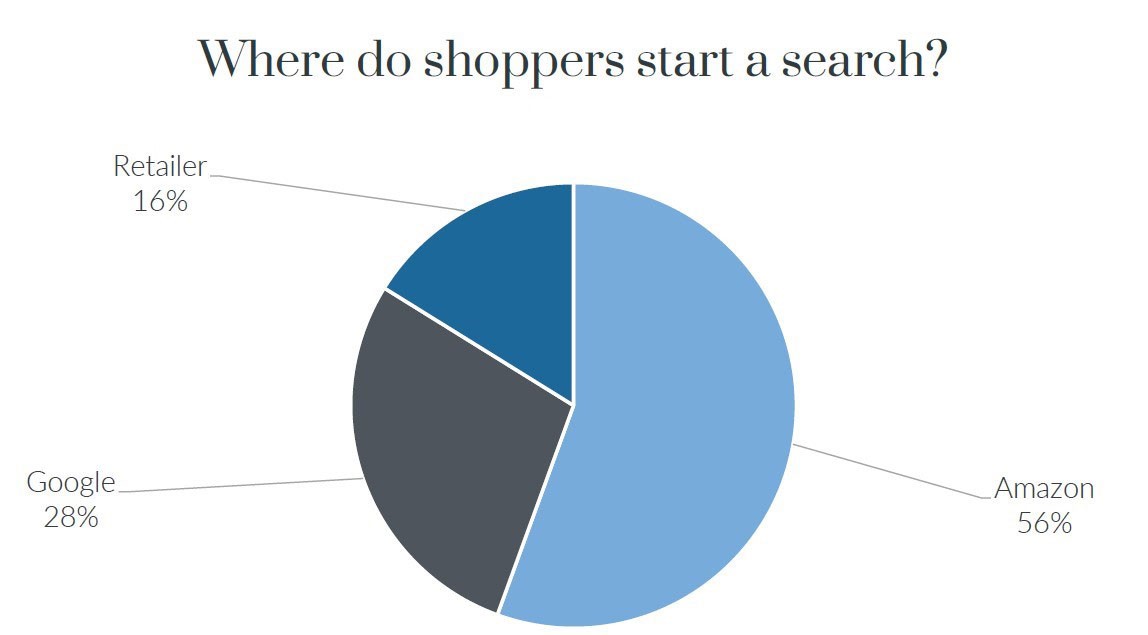
(Image Credit: Edit)
From these findings, it’s clear that you should optimize your listing both for Amazon and Google.
Test your SEO in 60 seconds!
Diib is one of the best SEO tools in the world. Diib uses the power of big data to help you quickly and easily increase your traffic and rankings. Diib will even let you know if you already deserve to rank higher for certain keywords. As seen in Entrepreneur!
- Easy-to-use automated SEO tool
- Keyword and backlink monitoring + ideas
- Speed, security, + Core Vitals tracking
- Intelligently suggests ideas to improve SEO
- Over 500,000 global members
- Built-in benchmarking and competitor analysis
Used by over 500k companies and organizations:
Syncs with 
Where to Add Amazon Keywords
You must use relevant keywords if you want a product page that Amazon will rank high, as discussed above. However, you need to place those keywords at the right location while avoiding keyword stuffing.
You Might Also Like
Amazon has outlined a list of keywords do’s and don’ts to guide you. Optimizing your product should be done carefully. It will help if you write your descriptions and titles in a manner that can be understood easily by Amazon’s search engines and is appealing to your potential buyers.
Here are the important places to include the relevant keywords:
Product Description
Most sellers tend to ignore providing a detailed description and putting their keyword in it because they don’t think it’s important. However, it’s very crucial.
Your potential buyer can be compelled to purchase the product you are selling if the description is detailed. Bad product descriptions can lower your click-through rate (CRT) and increase your bounce rate.
In turn, this sends a negative message to Amazon’s search engine and can make your product to be pushed down the search results.
So, how can you create an amazing description? It’s simple! Just think about your product and the benefits it offers or the problem it solves. Highlight the benefits and then answer all the questions customers may have about the product.
Product Title
The products’ title is another thing you should look at because it determines whether a customer browsing on Amazon will click on your product listing from the search results.
For this reason, you should put your keywords at the beginning of the product title. It would help if you also used a related keyword with the highest search volume in the title to increase your visibility and rankings.
Your Amazon Seller Account
The backend of your seller account can also be a good place to include your keywords. It helps Amazon’s search engines understand the contents of your page.
Here’s a quick guide on how you can access and include keywords in your backend’s seller account:
- Locate the ‘Inventory’ button and click on it.
- Click the ‘Edit’ tab beside the products.
- Find the offer button in the ‘Edit Product Info’ section.
- Click on ‘Keywords’ to access the ‘Search Terms’ section.

(Image Credit: Jungle Scout)
Once you are in this section, put your relevant keywords into your seller account. However, you can only use 250 characters, so you won’t include many keywords.
It’s also important to note that you should avoid using punctuations, including semicolons and commas, in your backend to separate the keywords as this can waste the limited characters.
Just use the most descriptive keywords related to your products with the highest search volume.
Facts About Amazon Keyword Research
There are several good things about Amazon keyword research, including:
Amazon Uses Several Keyword Ranking Factors
Amazon considers many things before ranking your product in the top search results. Here are some of the factors:
- The rating and number of your reviews. Amazon only shows top-rated products to guarantee customer satisfaction.
- The percentage rate of your product’s visit/unit, which Amazon calculates by dividing the number of visits to your product’s page and the units the product has sold.
- The relevance of your product based on the description, short bullet points and title.
- The number of shoppers that put your product in their carts.
- The number of sales your product has made.
Although some of these factors take time before yielding results, you can boost your listing’s relevancy with keywords.
You can use many amazon SEO tools to know which keywords to use in your product listing so that you maximize your relevancy.
Let’s now take a look at some of the tools to find these profitable keywords. Some of these amazon SEO tools are free, and others are paid.
Keyword Tool
This amazon keyword planner tool is designed to help buyers find your product faster. It has both free and paid plans. With the free version, you can create up to 750 long-tail keywords for each search term.
However, the paid version provides access to more keywords. Using the keyword tool is simple. You need to type the word that describes the product you are selling and then click the search button to know the keyword’s search volume.
Using the tabs, you can also switch between Amazon and Google easily to get relevant keywords for your product. The tool also provides accurate data. Here is an example of some keywords this tool produced:
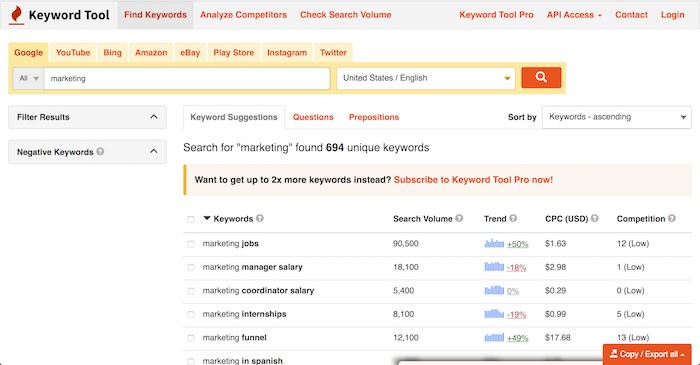
(Image Credit: Neil Patel)
Google Keyword Planner
Google keyword planner is one of the best amazon SEO tools free. You can use it to compare and monitor keyword trends with estimated search volumes for different keywords. With the tool, you can also find related keywords.
Plus, you can segment data by region, which makes it useful, especially if you’re selling to different countries. To use this Amazon keyword generator free, you need to create an Adwords account.
However, you don’t have to spend money or create active campaigns. You can find this keyword generator under the Tools tab after creating your account. The tool also allows you to conduct keyword research by checking your competitor’s site. The image below shows an example of the Google Keyword Planner:

(Image Credit: Ahrefs)
Scientific Seller
The Scientific Seller is another great Amazon SEO tool free. The tool helps sellers gain up to a 10% increase in monthly sales. The keyword tool is easy to use and offers accurate buyer keyword data.
Although the platform is slow, it delivers quality information for Amazon sellers. The Amazon keyword generator free also provides relevant keywords from several real-time sources.
In turn, this results in long-tail keywords your potential buyers are using to search for your products and which your competitors don’t know. For instance:

(Image Credit: KlientBoost)
Viral Launch
The viral launch is another excellent keyword generator tool. Like the Keyword Tool, this software also offers both free and paid versions. It also has a user-friendly dashboard on the left with all the necessary functions.
To find a relevant keyword, you need to select a trial keyword and then click the search button. You’ll then see a description of the keywords, average prices, and search volume trends. For example:

(Image Credit: Viral Launch)
To use any of the paid plans, you’ll need to pay a monthly fee depending on your subscription.
Ahrefs Site Explorer
Although Ahrefs Site Explorer is used for analyzing backlinks, you can also use it to conduct Amazon keyword research. It also reveals the keywords that are driving traffic to your competitor’s product pages from organic searches.
This way, you can use the same keywords to optimize your pages and have a share of your rival’s traffic. You can also use the dashboard to check various metrics and analyze your rival’s data.
However, it would help if you used the built-in filters to choose the keywords relevant to your business since a high-traffic page can rank for many keywords on Amazon. For example:

(Image Credit: Ahrefs)
Keyword Tool Dominator
This paid tool uses an auto-complete function to come up with relevant keywords. Keyword Tool Dominator is easy to use and is based on search volume, CPC (Cost per Click), Competition, and Trend. For instance:
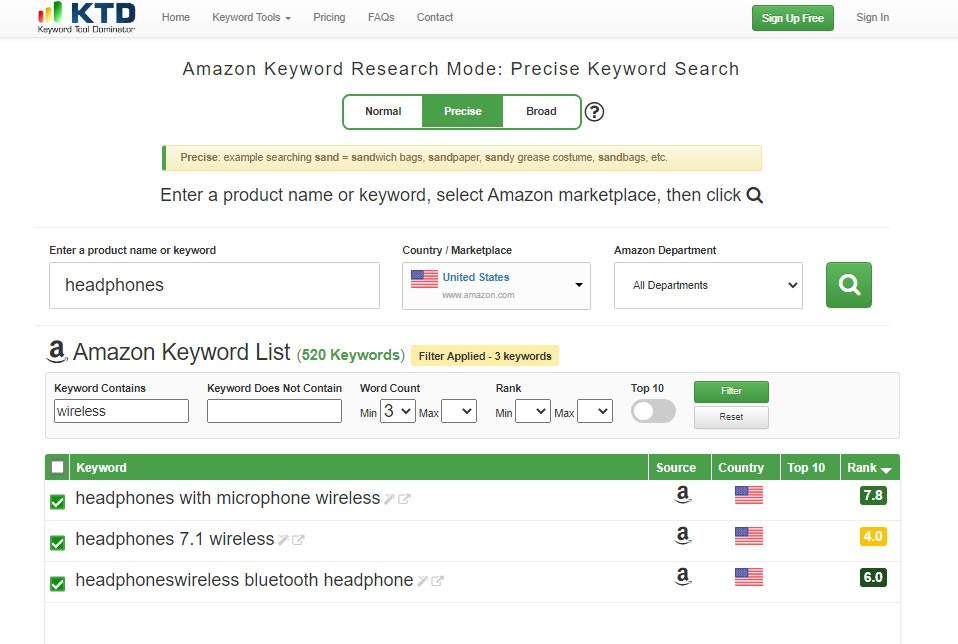
(Image Credit: Top Sellers Hub)
This amazon keyword generator tool is great at creating products with unique selling points and finding new niches. It also comes with several useful features, including supplier tracking, FBA training, sales tracking, customized emails, and more.
JungleScout
JungleScout has all the features you need to analyze Amazon’s search results and boost conversion rates. This tool allows you to double-check whether promoting a certain product is worth your effort.
Apart from conducting product research, JungleScout will also enable you to launch your product the right way, discover consumer search trends, and create better product listings for your customers using its powerful tracking features.
Using this paid amazon keyword generator tool is simple. Just mention the attributes and qualities of your product and allow the tool to do the rest.

(Image Credit: JungleScout)
KeywordInspector
KeywordInspector has the largest number of Amazon keywords in its database. The tool comes with multiple features to help you have an advantage over your rivals. The features can help you optimize, sell, or find more products quickly on Amazon.
For example, the Trending Keyword Search feature allows sellers to check new keywords every day or weekly. Other great features include the Reverse ASIN and Indexation Tester that allows you to optimize your products to reach the right shoppers. Here is what a keyword search could look like:
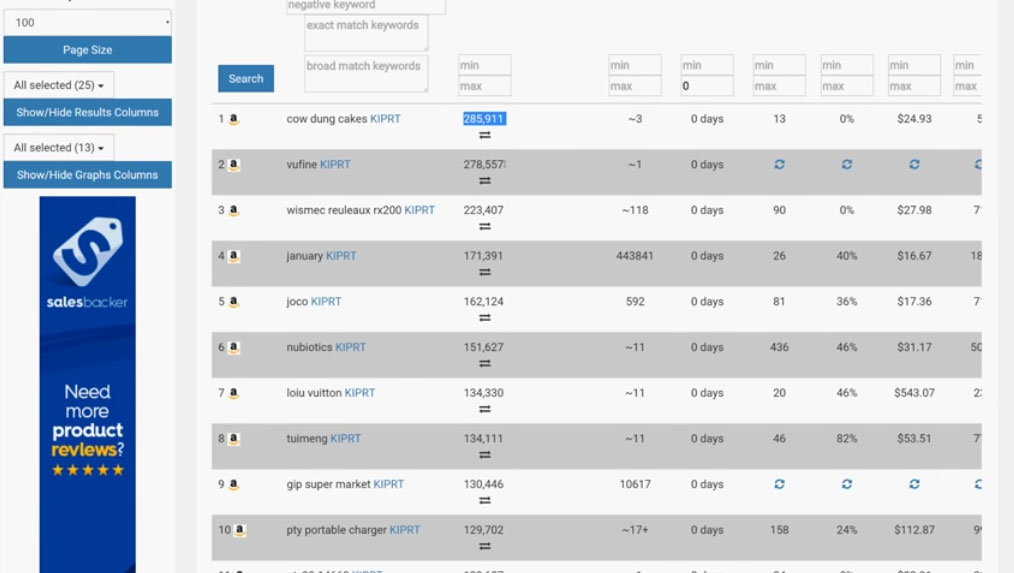
(Image Credit: sNews CMS)
The tool isn’t free. So, you need to buy a monthly subscription or purchase credits for the features you want.
MerchantWords
MerchantWords is an excellent tool for online sellers that want to boost their sales. You can use this keyword tool to check for valuable keywords, even if you are not an SEO expert.
It also has several keywords with buyers’ search trends over the last six years. The tool can help you optimize your product listings so that more buyers find your product.
MerchantWords also has a user-friendly interface with a seasonality feature that allows you to know how often buyers search for a keyword, whether monthly or during a certain holiday.
However, you’ll need to pay to find related keywords, store keywords list, and access all the other features.
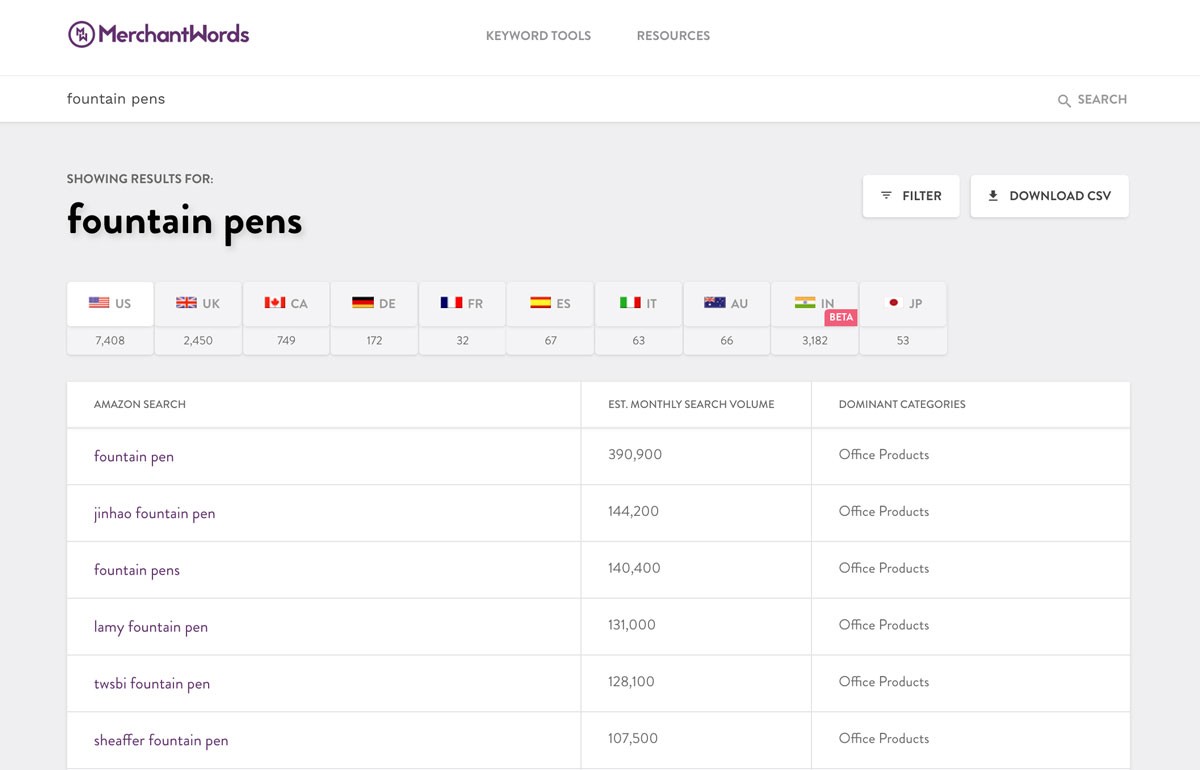
(Image Credit: MerchantWords)
Seller App
With Seller App, you can increase your product’s performance on Amazon. You can also discover valuable keywords with low competition. The app also allows sellers to spy on their competitor’s keywords and offers both free and paid versions. The image below shows you what the Seller App looks like:
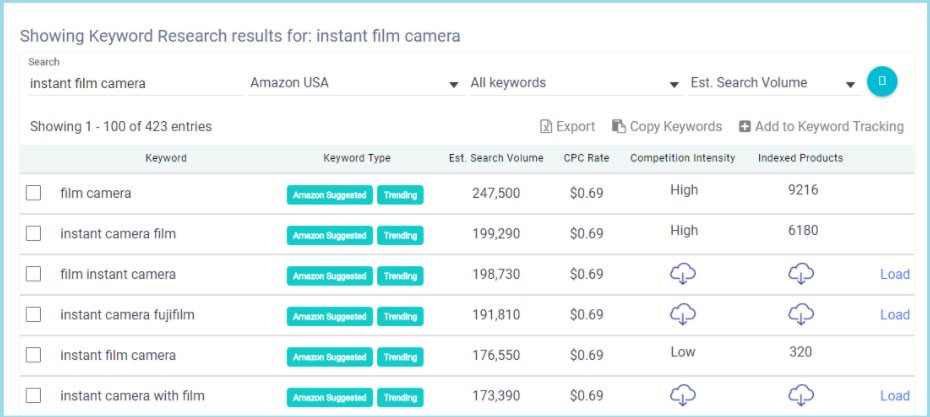
(Image Credit: Seller App)
Some Bonus Amazon SEO Tips
Like most beginner Amazon sellers, you probably can’t afford to purchase Amazon ads to promote your page and products. That’s why you should improve your Amazon SEO to rank over time organically.
It’s a lot of work, but the results are rewarding. Below are the tips to help you do it the right way:
Go for Long Tail Keywords
Long-tail keywords have lower search volume and are easy to rank for because they are less competitive. On the other hand, short tail keywords have a higher monthly search volume. However, they are more competitive.
While you may think using keywords with high search volume will generate a lot of sales, that is not the case with product searches. Compared to shorter terms with high volume, long-tail keywords tend to convert better, making them ideal for the online marketplace.
You can use both keywords. However, ensure you include a lot of long-tail keywords when creating your product listings. They may not give you many clicks, but shoppers who find your page through long-tail keywords will likely convert and buy your products.
Understand Shopper Buying Trends and Habits
This is crucial as it will help you plan your promotional strategies so that you advertise your products when a lot of people are shopping.
How does this impact Amazon SEO?
First, it allows you to optimize your product listings using the most searched keywords during that period. It also increases reviews and sales, sending a good ranking signal to Amazon’s search engines.
For instance, if the product you are selling brings in high revenue during Valentine’s Day, this could mean many customers are buying the product as a Valentine’s Day gift.
Based on that data, you can change your product’s description and title to match that season’s shopping trends. For example, you can include keywords like “best gifts for Valentine’s Day.”
We hope that you found this article useful.
If you want to know more interesting about your site health, get personal recommendations and alerts, scan your website by Diib. It only takes 60 seconds.
Spy on Your Rivals
Like any other business, it’s essential to find out your competitors’ strategies. Research what they are doing well and do it better to succeed on Amazon.
Generate new keyword ideas using any amazon keyword generator tool that’s free to find the keywords they are already ranking for and then add new ideas to your optimization strategy.
Diib®: SEO Metrics and Tools to Boost Amazon Sales
Optimizing your Amazon product page and listings is easy, using the strategies and the tools we have highlighted above. Every Amazon keyword planner tool above can help you conduct keyword research so that you optimize your product listings and increase sales. Diib Digital will also give you actionable analytics designed to fine-tune your Amazon campaign. Here are some of features of our User Dashboard we’re sure you’ll love:
- Customized Objectives give you simple tasks designed to optimize your website
- Alerts that tell you about your Domain Authority other technical SEO issues
- Bounce rate monitoring
- Post performance
- Broken pages where you have backlinks (404 checker)
- Keyword, backlink, and indexing monitoring and tracking tools
- User experience and mobile speed optimization
Click here for your free scan or simply call 800-303-3510 to speak to one of our growth experts.
FAQ’s
The first thing to remember is to try and avoid repeating any words. Quotation marks should also be avoided as they limit your overall character count. Commas are also ignored. Include variations of words (spelling or synonyms).
Pricing for PPC advertising on Amazon can vary a great deal. The average CPC is around $0.77. As this is an average, you may see higher or lower prices.
Amazon allows 250 characters total. The first line of the keyword fields will accept more than 250 characters so you can just put all the keywords there.
As this article has discussed, to rank higher on Amazon you need to optimize your product pages and use the tools mentioned. Providing relevant and complete information will help people find your products quickly and easily. Make sure you are competitively priced as well.
If you are selling a product that has a 10% conversion rate, that means it takes an average of 10 clicks to make one sale.



